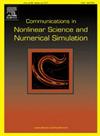用拉格朗日描述子揭示分数阶微分方程描述的动力系统的相空间结构:在Duffing振子中的应用
IF 3.4
2区 数学
Q1 MATHEMATICS, APPLIED
Communications in Nonlinear Science and Numerical Simulation
Pub Date : 2025-05-08
DOI:10.1016/j.cnsns.2025.108848
引用次数: 0
摘要
我们展示了拉格朗日描述子方法在定性地理解由分数阶微分方程控制的动力系统的潜在动力学行为方面的效用。特别地,我们使用拉格朗日描述子方法研究了分数阶微分方程控制非强制无阻尼Duffing振荡器的时间演化时的相空间结构。我们的研究考虑了Riemann-Liouville和Caputo分数导数。我们使用gr本文章由计算机程序翻译,如有差异,请以英文原文为准。
Using Lagrangian descriptors to reveal the phase space structure of dynamical systems described by fractional differential equations: Application to the Duffing oscillator
We showcase the utility of the Lagrangian descriptors method in qualitatively understanding the underlying dynamical behavior of dynamical systems governed by fractional-order differential equations. In particular, we use the Lagrangian descriptors method to study the phase space structure of the unforced and undamped Duffing oscillator when fractional-order differential equations govern its time evolution. Our study considers the Riemann–Liouville and the Caputo fractional derivatives. We use the Grünwald–Letnikov derivative, which is an operator represented by an infinite series, truncated suitably to a finite sum as a finite difference approximation of the Riemann–Liouville operator, along with a correction term that approximates the Caputo fractional derivative. While there is no issue with forward-time integrations needed for the evaluation of Lagrangian descriptors, we discuss in detail ways to perform the non-trivial task of backward-time integrations and implement two methods for this purpose: a ‘nonlocal implicit inverse’ technique and a ‘time-reverse inverse’ approach. We analyze the differences in the Lagrangian descriptors results due to the two backward-time integration approaches, discuss the physical significance of these differences, and eventually argue that the ‘nonlocal implicit inverse’ implementation of the Grünwald–Letnikov fractional derivative manages to reveal the phase space structure of fractional-order dynamical systems correctly.
求助全文
通过发布文献求助,成功后即可免费获取论文全文。
去求助
来源期刊

Communications in Nonlinear Science and Numerical Simulation
MATHEMATICS, APPLIED-MATHEMATICS, INTERDISCIPLINARY APPLICATIONS
CiteScore
6.80
自引率
7.70%
发文量
378
审稿时长
78 days
期刊介绍:
The journal publishes original research findings on experimental observation, mathematical modeling, theoretical analysis and numerical simulation, for more accurate description, better prediction or novel application, of nonlinear phenomena in science and engineering. It offers a venue for researchers to make rapid exchange of ideas and techniques in nonlinear science and complexity.
The submission of manuscripts with cross-disciplinary approaches in nonlinear science and complexity is particularly encouraged.
Topics of interest:
Nonlinear differential or delay equations, Lie group analysis and asymptotic methods, Discontinuous systems, Fractals, Fractional calculus and dynamics, Nonlinear effects in quantum mechanics, Nonlinear stochastic processes, Experimental nonlinear science, Time-series and signal analysis, Computational methods and simulations in nonlinear science and engineering, Control of dynamical systems, Synchronization, Lyapunov analysis, High-dimensional chaos and turbulence, Chaos in Hamiltonian systems, Integrable systems and solitons, Collective behavior in many-body systems, Biological physics and networks, Nonlinear mechanical systems, Complex systems and complexity.
No length limitation for contributions is set, but only concisely written manuscripts are published. Brief papers are published on the basis of Rapid Communications. Discussions of previously published papers are welcome.
 求助内容:
求助内容: 应助结果提醒方式:
应助结果提醒方式:


